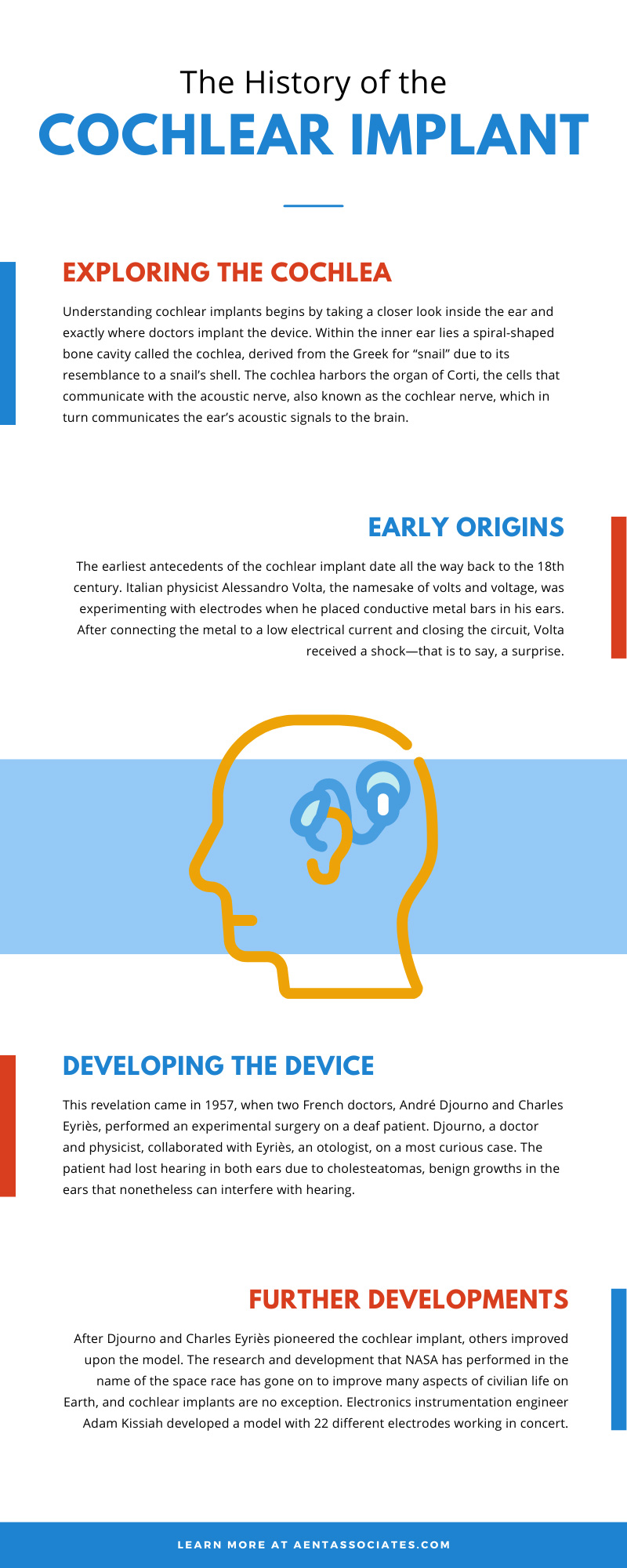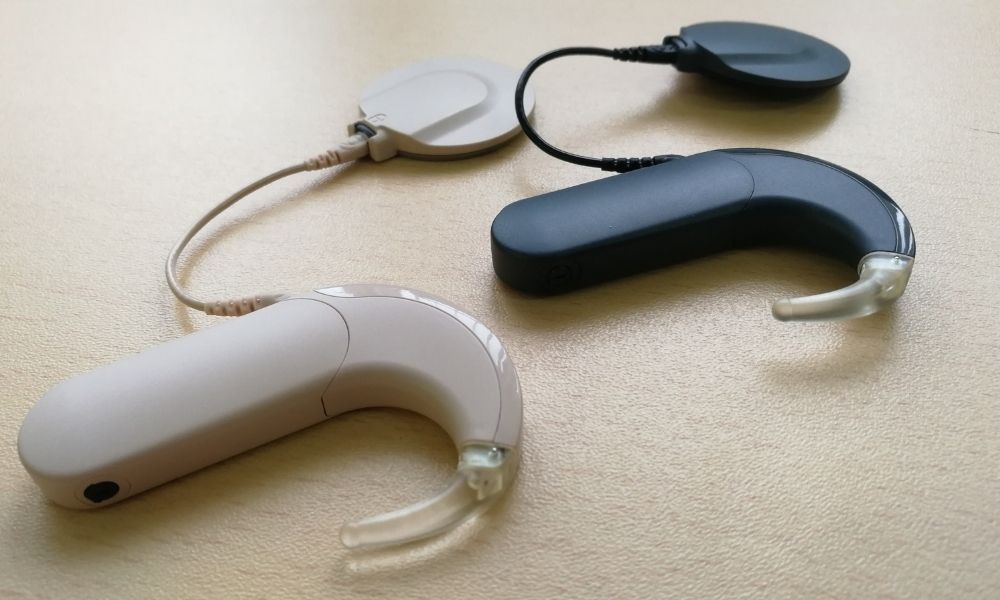While hearing aids have been able to restore this important sense to those who are hard of hearing, for many years there was no solution to profound or total hearing loss. That changed in the late 20th century with the innovation of the cochlear implant. By using a microphone and an electric current to stimulate a nerve in the ear, people who have suffered significant hearing loss or were born deaf can enjoy a reasonable simulacrum of sound even without normal acoustic perception. Let’s explore the history of the cochlear implant and how this device has changed lives.
Exploring the Cochlea
Understanding cochlear implants begins by taking a closer look inside the ear and exactly where doctors implant the device. Within the inner ear lies a spiral-shaped bone cavity called the cochlea, derived from the Greek for “snail” due to its resemblance to a snail’s shell. The cochlea harbors the organ of Corti, the cells that communicate with the acoustic nerve, also known as the cochlear nerve, which in turn communicates the ear’s acoustic signals to the brain. If the cells in the organ of Corti are damaged or absent, hearing loss occurs.
Early Origins
The earliest antecedents of the cochlear implant date all the way back to the 18th century. Italian physicist Alessandro Volta, the namesake of volts and voltage, was experimenting with electrodes when he placed conductive metal bars in his ears. After connecting the metal to a low electrical current and closing the circuit, Volta received a shock—that is to say, a surprise. He reported that he heard “the boiling of a viscous liquid,” even though no boiling liquid was present. This breakthrough did not enjoy constant progress in subsequent years. What happened, we would learn years later, was that Volta had stimulated the cochlear nerve.
Developing the Device
This revelation came in 1957, when two French doctors, André Djourno and Charles Eyriès, performed an experimental surgery on a deaf patient. Djourno, a doctor and physicist, collaborated with Eyriès, an otologist, on a most curious case. The patient had lost hearing in both ears due to cholesteatomas, benign growths in the ears that nonetheless can interfere with hearing. Surgeries to remove the cholesteatomas did not go as planned. Not only did the patient lose his hearing, but he also suffered facial paralysis on both sides of the face. Exploratory surgery used electromagnetic currents to heat affected areas, but when these currents inadvertently touched the acoustic nerve, the patient, who was awake during the procedure, reported that he was able to hear.
Excited with the possibility of restoring his hearing, the patient requested Dr. Eyriès go forward with the highly experimental surgery of recreating the electromagnetic nerve stimulation with a permanent electrode. While repairing the damaged cranial nerve, Eyriès would also implant a device with a specially designed induction coil into the ear.
Further Developments
After Djourno and Charles Eyriès pioneered the cochlear implant, others improved upon the model. The research and development that NASA has performed in the name of the space race has gone on to improve many aspects of civilian life on Earth, and cochlear implants are no exception. Electronics instrumentation engineer Adam Kissiah developed a model with 22 different electrodes working in concert. Though this is no comparison with the thousands of hair cells that give our natural hearing its bandwidth, it set the groundwork for the modern models of cochlear implants we use today. The most recent models of cochlear implants use piezoelectric transducers, using principles similar to those that power the pickups on electric guitars, which offer increased durability and efficacy over previous bone-conduction transducers. These transducers expand the range of hearing upward into higher frequencies once thought inaccessible.
Controversies Around Cochlear Implants
On the topic of deafness, the legendary R&B musician Ray Charles had this to say: “To me, it’s the worst thing in the world. Imagine never being able to hear music, or to hear a loved one talk to you. Most people expect me to help the blind, but I don’t think they need help. After all, I’m blind, and I’m doing all right.”
Strong words most certainly informed by the speaker’s own blindness, but not all people share this sentiment. Despite the miracle of restoring a degree of hearing in the deaf, cochlear implants are not without their detractors in the deaf and deaf-advocacy community. The deaf community is fiercely protective of itself as a community that is not, in fact, suffering from “the worst thing in the world” and is indeed thriving without hearing. As such, the idea that deafness is a condition that doctors and scientists must cure is something of an existential threat. The congenitally deaf who undergo cochlear implantation can find themselves caught between two worlds, fully accepted by neither. The facsimile of hearing that the cochlear implant provides does not allow for the full and nuanced spectrum of hearing that allows one to enjoy music or perceive slight differences in tone, but by having some semblance of hearing, such patients are shunned by the deaf community as traitors or community members who are not in full standing.
Cochlear implants are not effective worldwide. Because of the limited spectrum of hearing they provide, tonal languages such as Mandarin, which make important distinctions between high, low, rising, and falling inflections on syllables, are imperceptible within the cochlear implant’s narrow bandwidth. Being unable to overcome this encumbrance in the most spoken language in the world invites allegations of a certain ethnocentrism around cochlear implants.
Determining Whether You Could Benefit
After learning about the history of the cochlear implant, its evolution, and its successes, you may want to pursue one for yourself. If you have prematurely and significantly lost your hearing, you may be able to reinstate a semblance of normality. Allergy & ENT Associates retains an audiologist to serve the Houston area with diagnoses and insights for patients who may be struggling with hearing loss. If you and our audiologist determine that a cochlear implant is the best approach, our services include implant mapping in preparation for further procedures to restore your hearing.



